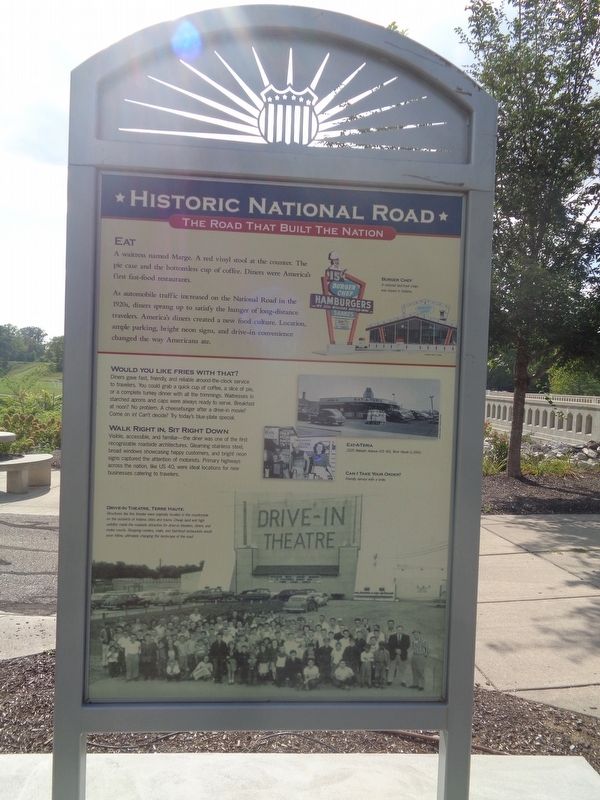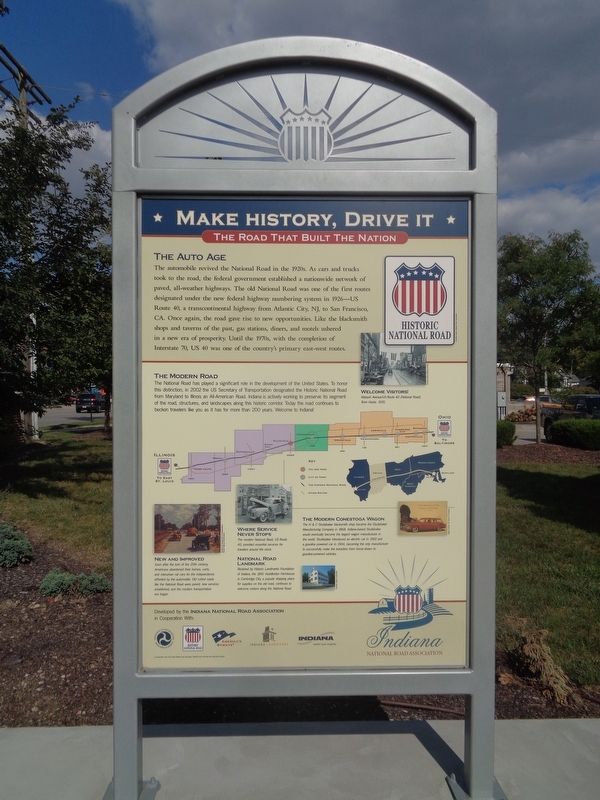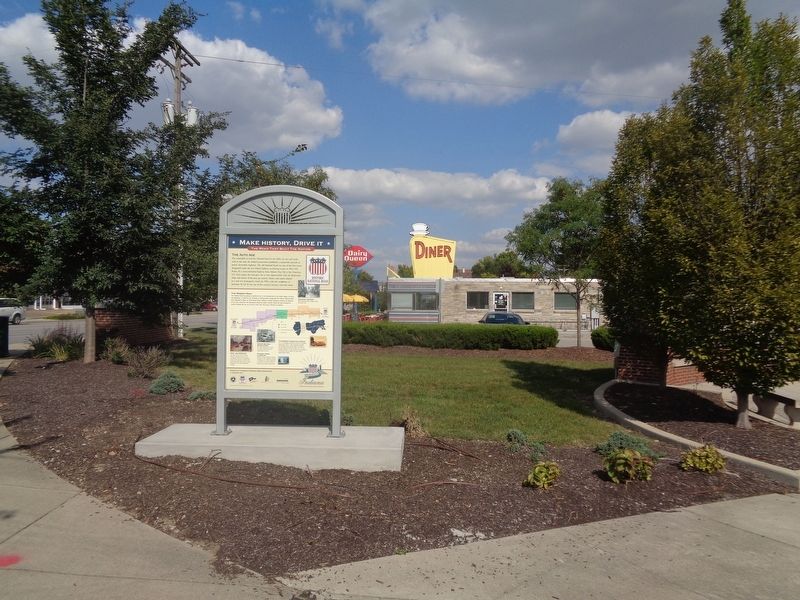Plainfield in Hendricks County, Indiana — The American Midwest (Great Lakes)
Eat
Historic National Road / Make History, Drive It
— The Road That Built the Nation —
As automobile traffic increased on the National Road in the 1920s, diners sprang up to satisfy the hunger of long-distance travelers. America's diners created a new food culture. Location, ample parking, bright neon signs, and drive-in convenience changed the way Americans ate.
Would You Like Fries With That?
Diners gave fast, friendly, and reliable around-the-clock service to travelers. You could grab a quick cup of coffee, a slice of pie, or a complete turkey dinner with all the trimmings. Waitresses in starched aprons and caps were always ready to serve. Breakfast at noon? No problem. A cheeseburger after a drive-in movie? Come on in! Can't decide? Try today's blue-plate special.
Walk Right In, Sit Right Down
Visible, accessible, and familiar - the diner was one of the first recognizable roadside architectures. Gleaming stainless steel, broad windows showcasing happy customers, and bright neon signs captured the attention of motorists. Primary highways across the nation, like US 40, were ideal locations for new businesses catering to travelers.
(photo captions:)
Drive-In Theatre, Terre Haute.
Structures like this theater were originally located in the countryside on the outskirts of Indiana cities and towns. Cheap land and high visibility made the roadside attractive for drive-in theaters, diners, an motor courts. Shopping centers, malls, and fast-food restaurants would soon follow, ultimately changing the landscape of the road.
(reverse:)
The Auto Age
The automobile revived the National Road in the 1920s. As cars and trucks took to the road, the federal government established a nationwide network of paved, all-weather highways. The old National Road was one of the first routes designated under the new federal highway numbering system in 1926—US Route 40, a transcontinental highway from Atlantic City, NJ, to San Francisco, CA. Once again, the road gave rise to new opportunities. Like the blacksmith shops and taverns of the past, gas stations, diners, and motels ushered in a new era of prosperity. Until the 1970s, with the completion of Interstate 70, US 40 was one of the country's primary east-west routes.
The Modern Road
The National Road has played a significant role in the development of the United States. To honor this distinction, in 2002 the US Secretary of Transportation designated the Historic National Road from Maryland to Illinois an All-American Road. Indiana is actively working to preserve its segment
of the road, structures, and landscapes along this historic corridor. Today the road continues to beckon travelers like you as it has for more than 200 years. Welcome to Indiana!
New and Improved
Soon after the turn of the 20th century, Americans abandoned their horses, carts, and interurban rail cars for the independence afforded by the automobile. Old rutted roads like the National Road were paved, new services established, and the modern transportation era began.
Where Service Never Stops
The modern National Road, US Route 40, provided essential services for travelers around the clock.
National Road Landmark
Restored by Historic Landmarks Foundation of Indiana, the 1841 Huddleston Farmhouse in Cambridge City, a popular stopping place for supplies on the old road, continues to welcome visitors along the National Road.
The Modern Conestoga Wagon
The H&C Studebaker blacksmith shop became the Studebaker Manufacturing Company in 1868. Indiana-based Studebaker would eventually become the largest wagon manufacturer in the world. Studebaker introduced an electric car in 1902 and a gasoline powered car in 1904, becoming the only manufacturer to successfully make the transition from horse-drawn to gasoline-powered vehicles.
Erected by Indiana National Road Association.
Topics and series. This historical marker is listed in these topic lists: Industry & Commerce • Roads & Vehicles. In addition, it is included in the The Historic National Road series list. A significant historical year for this entry is 2002.
Location. 39° 42.107′ N, 86° 24.336′ W. Marker is in Plainfield, Indiana, in Hendricks County. Marker is on West Main Street (U.S. 40) west of West Street, on the right when traveling east. Marker is located at Bicentennial Plaza, next to Oasis Diner. Touch for map. Marker is at or near this postal address: 455 W Main St, Plainfield IN 46168, United States of America. Touch for directions.
Other nearby markers. At least 8 other markers are within 7 miles of this marker, measured as the crow flies. T.H.I. & E. Interurban Depot Building (approx. 0.3 miles away); Van Buren Elm (approx. 0.3 miles away); Western Yearly Meeting House (approx. 0.4 miles away); Sugar Grove Meeting House (approx. 1.9 miles away); Adrian A. Parsons / Indiana's Soybean Pioneer (approx. 2.7 miles away); Site of "Masonic Well" (approx. 5 miles away); Indiana State Flag (approx. 6.4 miles away); Samuel Moore (approx. 6.4 miles away). Touch for a list and map of all markers in Plainfield.
Credits. This page was last revised on September 22, 2023. It was originally submitted on September 22, 2023, by Jason Voigt of Glen Carbon, Illinois. This page has been viewed 60 times since then and 14 times this year. Photos: 1, 2, 3. submitted on September 22, 2023, by Jason Voigt of Glen Carbon, Illinois.


